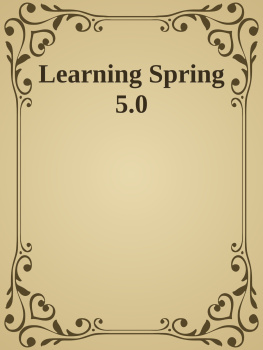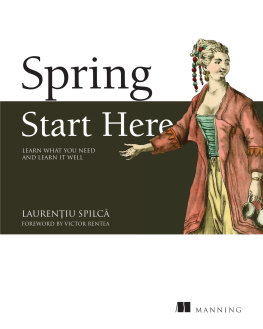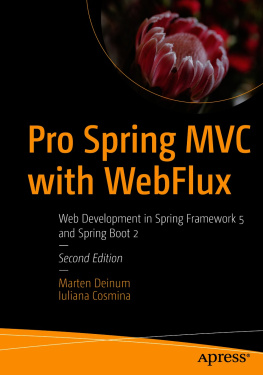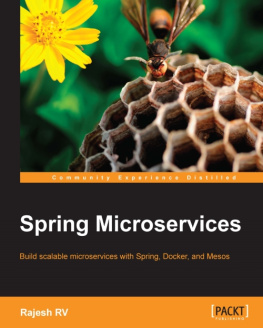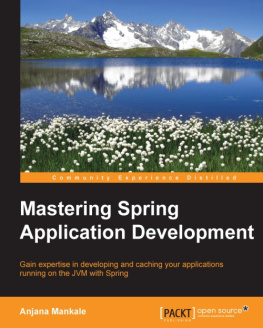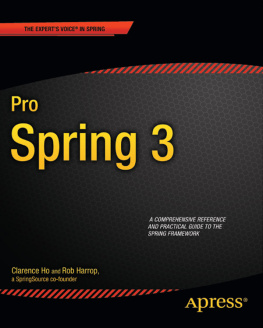Tejaswini Mandar Jog - Learning Spring 5.0
Here you can read online Tejaswini Mandar Jog - Learning Spring 5.0 full text of the book (entire story) in english for free. Download pdf and epub, get meaning, cover and reviews about this ebook. year: 2017, publisher: Packt Publishing, genre: Computer. Description of the work, (preface) as well as reviews are available. Best literature library LitArk.com created for fans of good reading and offers a wide selection of genres:
Romance novel
Science fiction
Adventure
Detective
Science
History
Home and family
Prose
Art
Politics
Computer
Non-fiction
Religion
Business
Children
Humor
Choose a favorite category and find really read worthwhile books. Enjoy immersion in the world of imagination, feel the emotions of the characters or learn something new for yourself, make an fascinating discovery.
- Book:Learning Spring 5.0
- Author:
- Publisher:Packt Publishing
- Genre:
- Year:2017
- Rating:5 / 5
- Favourites:Add to favourites
- Your mark:
Learning Spring 5.0: summary, description and annotation
We offer to read an annotation, description, summary or preface (depends on what the author of the book "Learning Spring 5.0" wrote himself). If you haven't found the necessary information about the book — write in the comments, we will try to find it.
- Build an enterprise application throughout the book that communicates with a microservice
- Define and inject dependencies into your objects using the IoC container
- Make use of Springs reactive features including tools and implement a reactive Spring MVC application
Spring is the most widely used framework for Java programming and with its latest update to 5.0, the framework is undergoing massive changes. Built to work with both Java 8 and Java 9, Spring 5.0 promises to simplify the way developers write code, while still being able to create robust, enterprise applications.
If you want to learn how to get around the Spring framework and use it to build your own amazing applications, then this book is for you.
Beginning with an introduction to Spring and setting up the environment, the book will teach you in detail about the Bean life cycle and help you discover the power of wiring for dependency injection. Gradually, you will learn the core elements of Aspect-Oriented Programming and how to work with Spring MVC and then understand how to link to the database and persist data configuring ORM, using Hibernate.
You will then learn how to secure and test your applications using the Spring-test and Spring-Security modules. At the end, you will enhance your development skills by getting to grips with the integration of RESTful APIs, building microservices, and doing reactive programming using Spring, as well as messaging with WebSocket and STOMP.
What you will learn- Get to know the basics of Spring development and gain fundamental knowledge about why and where to use Spring Framework
- Explore the power of Beans using Dependency Injection, wiring, and Spring Expression Language
- Implement and integrate a persistent layer in your application and also integrate an ORM such as Hibernate
- Understand how to manage cross-cutting with logging mechanism, transaction management, and more using Aspect-oriented programming
- Explore Spring MVC and know how to handle requesting data and presenting the response back to the user
- Get to grips with the integration of RESTful APIs and Messaging with WebSocket and STOMP
- Master Reactive Programming using Spring MVC to handle non-blocking streams
Tejaswini Mandar Jog is a passionate and enthusiastic Java trainer. She has more than nine years of experience in the IT training field, specializing in Java, J2EE, Spring, and relevant technologies. She has worked with many renowned corporate companies on training and skill enhancement programs. She is also involved in the development of projects using Java, Spring, and Hibernate. She wrote a book, Learning Modular Java Programming, which explores the power of modular programming for building applications with Java and Spring.
She was reading about Spring 5 on the internet when she got an email asking whether she would be interested in writing a book on Spring 5.0. It was a really big responsibility for her to work on this project. She had worked with Spring before, but this was altogether an exciting new experience. They decided to take up the challenge, she and Mandar (her better half).
Table of Contents- Introduction to Spring
- Dependency Injection
- Accelerate with Spring DAO
- Aspect Oriented Programming
- Be Consistent : Manage Transaction
- Explore Spring MVC
- Be Assured: Take a Test Drive
- Make it Safe : Security Management
- Explore the Power of RESTFul Webservices
- Exchange Information: Use Messaging
- Be Active : Reactive Programming using Spring
Tejaswini Mandar Jog: author's other books
Who wrote Learning Spring 5.0? Find out the surname, the name of the author of the book and a list of all author's works by series.

